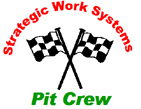The “breakthrough strategy” discussed in my last column works. (See the “Breakthrough Strategy for Changing Behaviors” post.) Equipment becomes more reliable, costs go down, and behaviors change along the way. The key is focusing on results—the kind of results that will get people’s attention on the plant floor as well as in the key decision– makers’ offices. Select the equipment that, if it ran better and was more reliable, would generate sizeable savings. But more importantly, choose equipment that would generate more throughput and revenue. Focus on that equipment and virtually pull out all the stops. Put the applicable “best practices in place” only on that equipment and help everyone understand why.
But beware! The biggest mistake I have seen companies make is that they begin with a “focus on results” approach. Then somewhere just a short distance into the mission, they default to the same old thing—implementing a program on a broad scale—and they lose sight of what they set out to do: improve the reliability of a selected piece of equipment. It’s fairly easy to become enamored with setting up a new program to improve broad–scale performance. It’s fairly easy to get a small group of people rallied around a maintenance improvement project. The problem with this “activity-based” approach is that the enthusiasm typically runs out before the sustainable results are realized. How many times have we heard about successfully installing a CMMS, or a preventive maintenance program, or a training program but then we haven’t been able to show the top decision–makers a return on investment? Or perhaps short–term improvements just were not sustained.
Here is the key: Stay focused on results. If the goal is to improve performance, be specific. Focus on the desired results, and measure the progress every step of the way. If it doesn’t improve, try something else. Engage the people who work in, on, and around the equipment in the improvement activities every step of the way if you hope to change, or at least influence, the way they operate and maintain the equipment.
For example, one of our clients had a lube oil problem. In a recent three-month period, they spent more than $70,000 on lube oils for rotating equipment (compressors, engines, pumps, etc.). This was excessive and had to be attacked. When focusing on improving the performance of four pieces of rather large critical equipment, we repeatedly stressed the need to not just stop oil leaks but seek to eliminate the causes. Two reasons were discussed. One was easy: By stopping leaks, we will reduce the cost of lube oils. The second reason, which was not as obvious, was also easy: Leaking lube oil means that a component that depends on regular lubrication is probably not getting it. And this type of leak will result in premature equipment failure.
After spending a day on the equipment with the operators and maintenance mechanics discussing the woes of leaking lube oil, the oil consumption was reduced from an average of 12 to 14 gallons per day down to four gallons. The workplace and the equipment looked cleaner because the leaks were eliminated, and it definitely was easier to work there without getting dirty and oily.
The next step was to address contamination found in the lube oil that contributes to premature failure since these four large machines have each experienced a catastrophic failure within the past 12 months and signs of lubrication problems were discovered. The same work group found at least four sources of water and sand getting into the oil:
- The bulk oil tank had a screw cap (bung) in the top, and it was stored outside.
- The rubber oil transfer lines were draped over the handrail, also outside.
- The fittings and hoses from the bulk oil tank to the day tank and from the day tank to the equipment were designed for compressed air, not liquids.
- The pump used to transfer oil to the equipment was stored on the floor with its inlet and outlet ports uncovered.
We also found that oil sampling and analysis was done on an intermittent basis and never on the new oil from the bulk tank.
The good news is that they have begun hard piping the oil lines, storing the bulk tank under cover, and have developed a procedure for regularly sampling oil from the bulk tank and the equipment.
I tell this story because it is an example of focusing on results. Our client could have lost focus and implemented a massive lube oil cost cutting program by stopping leaks. In their work culture, it is common knowledge that “Equipment is designed to leak” and “Leak containment is what we need to do.” Results were achieved and new practices were learned by involving the workgroup in a focus on four specific machines. There was a clear business case to improve performance and reduce costs. The benefits of this short session were seen not only by the workgroup but also by the management and leadership at many levels in the organization. The next step is to build on this success and target other reliability and work culture issues on the same equipment.
© 1998
Robert M. Williamson
Strategic Work Systems, Inc.
Columbus, NC 28722
[email protected]
![]() Download a PDF of this article by clicking here Focus on Results Part 1
Download a PDF of this article by clicking here Focus on Results Part 1
